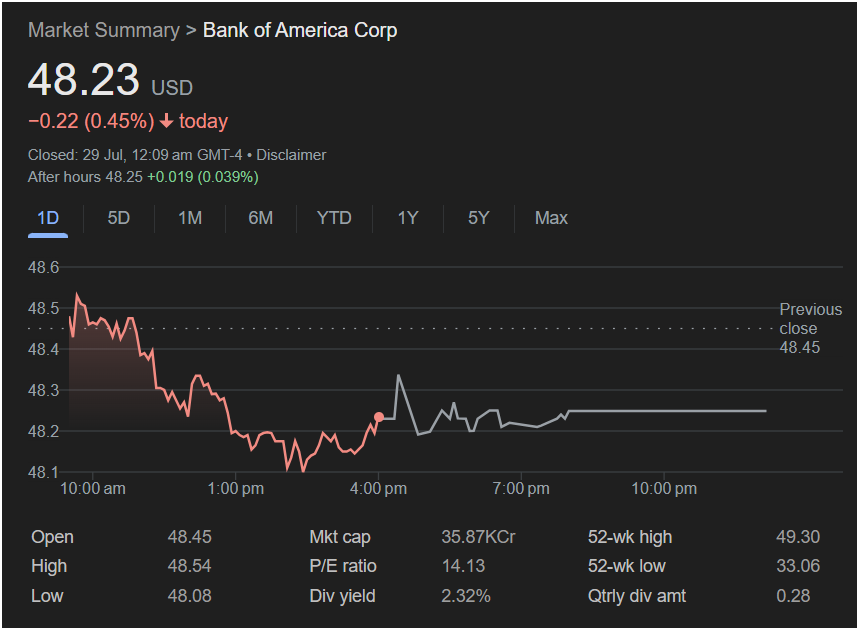Bank of America (BAC) Stock Slips, But Holds Near Yearly Highs as Investors Gauge Market Signals

NEW YORK – Shares of Bank of America Corp (NYSE: BAC) experienced a modest pullback in a recent trading session, closing at $48.23. The financial titan saw its stock value decrease by $0.22, or 0.45%, reflecting a day of measured volatility and investor deliberation on the broader economic landscape.
Despite the daily dip, the stock showed signs of life in after-hours trading, inching up to $48.25. The day’s performance keeps the banking giant hovering near its 52-week peak, highlighting a larger narrative of resilience and strength over the past year.
A Closer Look at the Day’s Trading
The session for Bank of America was a tale of intraday shifts in momentum. The stock began trading at $48.45, precisely where it had closed the previous day. An early burst of optimism pushed the shares to a high of $48.54 shortly after the opening bell.
However, selling pressure began to mount through the morning and into the afternoon, driving the stock to its session low of $48.08. This dip represented the primary driver of the day’s net loss. By the late afternoon, buyers re-emerged, helping the stock pare some of its losses and stabilize into the close. This pattern of a morning peak followed by a midday slump and a late recovery is often indicative of a market digesting new information and re-evaluating positions.
Key Metrics in Focus
For investors analyzing Bank of America’s fundamental health, the latest figures provide a mixed but compelling picture:
-
Valuation: The stock’s Price-to-Earnings (P/E) ratio stands at a reasonable 14.13. This metric, which compares the company’s share price to its earnings per share, suggests that BAC is not excessively overvalued compared to historical averages or some of its peers in the tech-driven market.
-
Market Capitalization: With a market cap in the realm of $358 billion, Bank of America remains one of the largest and most systemically important financial institutions in the world.
-
Investor Returns: For income-seeking investors, the dividend yield of 2.32% is a significant draw. This is supported by a consistent quarterly dividend payment of $0.28 per share, reinforcing the company’s commitment to returning capital to its shareholders.
Performance in a Wider Context
The daily fluctuation of a single stock rarely tells the whole story. Bank of America’s performance is intrinsically linked to the health of the U.S. and global economies. The entire banking sector is currently navigating a complex environment defined by questions around inflation, potential shifts in Federal Reserve policy, and the overall strength of the consumer.
Profitability for banks like BAC is heavily influenced by interest rate spreads—the difference between the interest they earn on loans and the interest they pay on deposits. As such, any hint of a change in monetary policy or a shift in economic growth forecasts can send ripples through banking stocks. Friday’s trading action can be seen as part of this larger, ongoing assessment by the market.
The 52-Week Perspective
While the one-day chart shows a slight decline, zooming out reveals a much more bullish trend. The stock’s current price of
49.30** than its 52-week low of $33.06.
This robust performance over the last year indicates strong underlying momentum and sustained investor confidence. The journey from the low of $33.06 underscores a significant recovery and growth period for the bank. The fact that the stock is now challenging its yearly high suggests that many investors believe its growth trajectory remains intact, viewing minor dips as potential buying opportunities rather than a reversal of the trend.
As the market heads into a new week, investors will be closely watching for catalysts that could sway sentiment. Upcoming economic data releases, commentary from Federal Reserve officials, and any company-specific news could determine whether Bank of America can successfully breach its 52-week high or if the broader market uncertainty will continue to foster this kind of day-to-day volatility.





